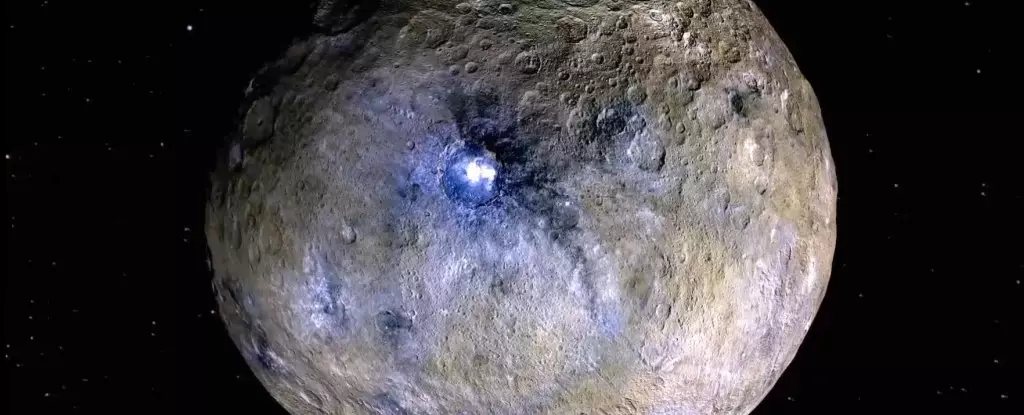Ceres, nestled within the asteroid belt between Mars and Jupiter, has long been a subject of intrigue and speculation. Originally classified as an asteroid upon its discovery in 1801, it has since gained the designation of a dwarf planet due to its size and spherical shape. Featuring a surface that appears rugged and heavily cratered, Ceres presents a unique opportunity to study how celestial bodies can resemble ocean worlds, yet possess characteristics that set them apart from their more well-known counterparts like Europa or Enceladus. Recent research suggests that Ceres might hold a significant amount of hidden water ice, possibly exceeding previous estimates by a considerable margin.
Traditionally, scientific models predicted that Ceres’ surface would be composed of no more than 30 percent water ice, a conclusion drawn from observations on the deformation patterns of craters. Scientists previously assumed that an icy surface would naturally flow and smooth out over time, akin to glaciers on Earth or honey on a stove. However, upon the arrival of NASA’s Dawn spacecraft in 2015, researchers encountered well-defined, resilient craters that challenged these assumptions. The unexpected persistence of Ceres’ craters indicated that the composition of the surface might be more complex than merely a thick layer of ice over a rocky core.
Mike Sori, a geophysicist at Purdue University, underscores this new understanding by proposing that a mixture of water ice and rocky impurities may contribute to Ceres’ remarkable surface features. Instead of gradual deformation, the presence of even a slight percentage of rock within the icy crust seems to provide enough structural integrity to preserve the craters. The insight gained from this research opens a new chapter in our understanding of not just Ceres, but also other icy celestial bodies.
In a pivotal study led by planetary scientist Ian Pamerleau, the research team developed sophisticated computer simulations that challenged prior assumptions. They focused on model scenarios that incorporated varying crustal structures to assess how different compositions could affect crater formation and longevity. Their findings indicate that a crust comprised of predominantly water ice, with a gradual decrease in ice content as one descends deeper, preserves the craters more effectively over extensive time periods.
Pamerleau elaborates, explaining that the dynamics of solid-state flow in such ice-rich environments could account for the observed lack of relaxation in Ceres’ craters. By analyzing various configurations through their simulations, they hypothesized that a predominantly icy upper layer, containing some rocky material, could have maintained the pronounced craters we see today. This revelation not only shifts the paradigm surrounding Ceres but may also influence how we interpret the geological characteristics of other icy bodies in the Solar System.
The implications of Ceres’ findings extend to understanding the composition of other oceanic worlds within our cosmic neighborhood. Various moons, such as Europa, Ganymede, Enceladus, and others, are believed to harbor subsurface oceans beneath thick layers of ice. While these moons benefit from tidal heating due to their gravitational interactions with their host planets, Ceres lacks such dynamics, having no larger celestial body to influence its temperature. This raises intriguing questions about the fate of its geological history—could Ceres have once possessed an underground ocean, only to freeze in a manner different from its more active counterparts?
Sori speculates that Ceres indeed may have once been an “ocean world” with a muddier ocean that ultimately froze, forming the icy crust we observe today. This perspective invites scientists to reevaluate the characteristics and life cycles of ocean worlds, suggesting that they may not all fit neatly into preconceived categories.
As we glean insights from Ceres, the potential for future exploration remains tantalizing. The dwarf planet stands out as a relatively accessible object for study compared to its more distant companions, making it a prime candidate for renewed missions. The possibility of Ceres harboring a frozen ocean world not only fuels scientific curiosity but also represents an exciting intersection of worlds and the prospect of finding analogs for extraterrestrial life.
Sori’s enthusiasm captures the essence of this ongoing research: Ceres represents a “frozen ocean world” that could provide valuable comparisons to other icy moons, particularly for understanding their potential for habitability. Its relative proximity to Earth positions Ceres as an advantageous target for missions aimed at unraveling the secrets of the universe’s oceanic bodies.
Ceres is much more than a mere remnant of the Solar System’s formation; it is a robust and complex celestial body that challenges our understanding of planetary science. By delving deeper into the mysteries of its icy crust and exploring its geological history, we may uncover vital lessons about the nature of ocean worlds, both in our Solar System and beyond. The surveys and studies undertaken thus far offer just a taste of what lies beneath the surface—both literally and metaphorically—of this intriguing dwarf planet.


Leave a Reply